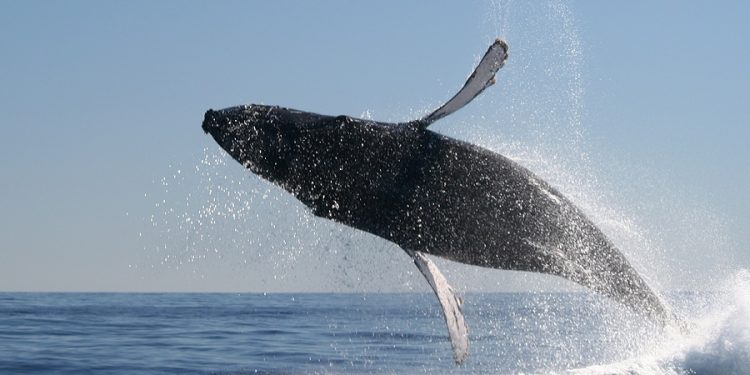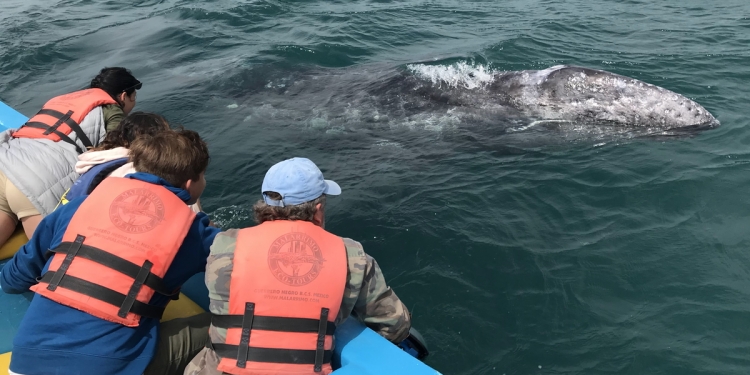California Gray Whales migrate away from the cold, food-rich, waters near Alaska to the warmer waters near Mexico to breed and bear their calves…
They begin arriving in November and from December to the end of March each year, there’s an opportunity to catch glimpses of the amazing Whales …
About Whales
Whale is the common name for marine mammals which belong to the Cetacean order, which also includes Dolphins and porpoises. Whales collectively inhabit all the world’s oceans and number in the millions, with annual population growth rate estimates for various species ranging from 3-13%.
Custom Whale Watching Tour in Mexico
An opportunity to marvel in the company of the majestic grey whales and their progeny as they frolic in the natural habitats off the coast of Baja California
Learn more about the tours and request a no-obligation quote
Whale Migration to Mexico
Every year, over 1,500 California Gray Whales migrate from the cold Bering and Chukchi waters near Alaska to the warm Pacific waters off the coast of Mexico’s Baja peninsula. The 6,000 mile journey brings these magnificent marine mammals to “sanctuaries” situated in lagoons off the shores of Baja California Sur.
The California Gray Whales were a species under threat; it was estimated that their numbers had diminished to less than 2,000. However, with a series of international treaties protecting them and a sterling effort by the Mexican government to protect these remarkable creatures, populations of the California Gray are recovering, and there are now estimated be around 20,000 in existence.
The whales leave their feeding waters off the shores of Alaska at the end of the summer and reappear off the coast of Mexico’s Baja peninsula sometime during November each year.
They arrive here to form courtship groups for mating or to bear the calves which were conceived the year before. When the mating and births are complete, and the temperatures in the northern hemisphere begin to rise, the whales return to the food-rich Alaskan waters pregnant, or with their newly born calves around mid March.
[Menu]
Whale Watching in Mexico
The whale watching season in Mexico is reasonably short: December to March each year. To see the whales you really need to take an organized boat trip (or a private boat charter) operated by an experienced skipper who knows where the whales are and how to approach them in the vessel without scaring them off. If you can’t take the boat ride, the best place to try and see whales from the shoreline is from the beaches near Todos Santos and the beaches facing south west near Cabo San Lucas.
Custom Whale Watching Tour in Mexico
An opportunity to marvel in the company of the majestic grey whales and their progeny as they frolic in the natural habitats off the coast of Baja California
Learn more about the tours and request a no-obligation quote
Advice for Whale Watching in Mexico
To help you prepare for your whale watching excursion, we have published a number of tips.
When to Go
You need to be in the Baja California Sur region of Mexico between December and March, which is when the California Gray Whale can be found in Mexican waters.
Breakfast
Eat a good, wholesome, breakfast; porridge or cereals and fruits are ideal. Don’t go whale watching on an empty stomach; also, you are less likely to suffer from motion sickness if you have eaten than not. Avoid too much greasy food and avoid alcohol before and during your excursion.
Binoculars and Camera
If you are experienced with binoculars, bring them along. Most people will not find them much use: it’s an art using binoculars on a moving boat and the field of vision is quite restricted.
A good camera with a zoom or telephoto lens is ideal. If it’s a non-digital camera bring plenty of film, if it’s a digital camera bring additional batteries.
Appropriate Footwear
Bring rubber soled shoes that will support your feet and your ankles as the boat moves and the waves hit up against the side of the vessel causing shudders or sudden movements. Flip-flops and heels are not appropriate on a whale cruise boat.
Motion Sickness
If you have never been on a long boat trip before, you might like to take some motion sickness medicine with you. You could purchase this at home or from any pharmacy in Mexico. You will need to take the medications before you board the vessel; it’s no use taking it once you are on the water.
Sun Block, Hat & Sun Glasses
Be sure you pack a high-factor sun block and a hat as there is little protection from the sun once you are out on the open waters of the Pacific (besides the boat canopy which may only provide partial cover). Over 50% of the suns rays bounce off the ocean’s surface and hit you – so you can burn even in shade. You can also sunburn under overcast skies as the sun’s UV rays can penetrate cloud. If you are traveling with children, be sure they are well protected from the sun with sun block a hat and sun glasses. The reflection of the water in your eyes over a prolonged period can give you temporary blindness and/or cause a headache.
Dress in Layers
The temperature on the open sea can be considerably lower than the temperature on land. Dress in layers and be sure you can keep warm. You might get wet and, if you do, you can also feel very cold in the wind. It’s a good idea to bring a lightweight waterproof jacket with a hood, as an outer layer in case the seas get choppy and the boat gets sprayed.
Upper Deck or Lower Deck?
Most Whale Cruise boats have two decks; an upper deck, which offers better distance visibility and a lower deck, which is closer to the water (and thus the whales, when they appear) but with restricted visibility at distances. It’s impossible to predict when or how the Whales will appear. There are very strict maritime guidelines about how a boat should approach and be maneuver around whales and the skipper may not be able to go in the direction that you think will offer you the best view.
Traveling with Children
A lot of time on a whale watching excursion can be taken up with waiting for the whales to appear. Children, especially young children, can get bored quickly with nothing to see or do. Bring crayons, coloring pads, books and small games to keep your children entertained during the day. Also pack a picnic lunch and bring plenty of bottled water.
Picnic Lunch
Pack a lunch with plenty of snacks, especially if you are traveling with children. fresh fruits, dried fruits, trail mix, bottled mineral water, etc are ideal foods that will give you and your children the energy you need to get through the day without creating a sugar-rush.
YouTube: Whale Watching in Baja California
Custom Whale Watching Tour in Mexico
An opportunity to marvel in the company of the majestic grey whales and their progeny as they frolic in the natural habitats off the coast of Baja California
Learn more about the tours and request a no-obligation quote
Whale Watching Tours in Mexico
Whales can sometimes be seen swimming off Mexico’s Pacific Coast as well as in the waters around Baja California Sur and the Sea of Cortes. Your viewing experience will depend on climatic and sea conditions, as well as how close or far the whales are from the shoreline.
However, for your best chance to see the whales, you should take a tour on a boat. Tours are organized by experts who know the local waters and know the best places to find the whales.
Custom Whale Watching Tour in Mexico
An opportunity to marvel in the company of the majestic grey whales and their progeny as they frolic in the natural habitats off the coast of Baja California
Learn more about the tours and request a no-obligation quote
Mexico in your inbox
Our free newsletter about Mexico brings you a monthly round-up of recently published stories and opportunities, as well as gems from our archives.


